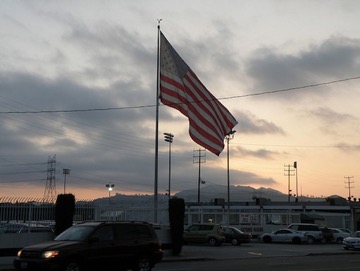Daily News Digest Archives
As the Capitalist Robber Barons Steal from the 99% — Only the 1% Voted For Austerity — The 99% Should Decide On Austerity — Not Just The 1% Who Profit From Austerity!
Daily News Digest February 6, 2017
Image of the Day:
Trump’s Billionaire Government: Pigs at the Trough Quotes of the Day:
Quotes of the Day:
This very expensive global warming bullshit has got to stop. Our planet is freezing, record low temps, and our GW scientists are stuck in ice. — Donald Trump, January 2, 2014
By definition, an article dealing with human extinction is highly provocative and touchy and generally dismissed as balderdash. After all, it sounds kinda crazy. Still, the named article: “Will Humans Be Extinct By 2026?” warrants serious consideration. Here’s why: The Arctic News blog is an amalgam of serious research by topnotch scientists that “speak to truth.” They endorse the distinct possibility of an extinction event that will catch humanity flat-footed. They really believe it is a serious risk. These scientists go against the grain, telling it as they see it, not pulling any punches. Conversely, it is well known that many climate scientists have been fudging their work; edits make bad seem less bad. Otherwise, those scientists stand to lose grants and funding. This is a fact confirmed by one of the world’s leading climate scientist (mentioned in prior articles). Ipso facto, fudging data is one of the bugaboos about accurate climate science, as scientists intentionally lowball. Assuredly, submitting the interrogatory “Will Humans Be Extinct By 2026?” suggests the existence of solid evidence. But, in general, people do not, and will not, believe it. After all, how could it be true? Therein lies the major impediment to taking steps to prevent the problems of climate change. In point of fact, there are several good ideas to ameliorate climate change, if pursued in earnest. — Human Extinction 2026
Video of the Day:
“Dakota” means friend Sometimes the truth leaks out
US:
Pigs at the Trough: Privatization of the Public Good Donald Trump has assembled a Cabinet distinguished by capitalist oligarchs, hedge-fund scammers and failed military officers. However, these officials – some have yet to receive Senate approval — share a common belief that the federal budget is a bottomless pig’s feeding trough to be plundered for private corporate and, ultimately, management and shareholder personal enrichment. by David Rosen
Unspeakable: the Black Book of Imperial Terrorism American “mainstream” journalists who want to keep their paychecks flowing and their status afloat know they must report current events in a way that respects the taboo status of the nation’s underlying inequality and oppression structures and its savage and relentless imperial criminality. Those topics are understood as off limits, as beyond the narrow parameters of acceptable and polite discussion. They are subjects that serious reporters and commentators have the deeply indoctrinated common sense to avoid. by Paul Street Trump just received the lowest approval rating in recent history for a new president By Brett LoGiurato
Trump just received the lowest approval rating in recent history for a new president By Brett LoGiurato  Before Trump, the Border Wall Was a Bipartisan Project by Oliver Ortega
Before Trump, the Border Wall Was a Bipartisan Project by Oliver Ortega 
Wall Street Bigger and Badder Than Ever Being a banker means never having to say sorry. Or worry where that next million is going to come from. Financial results are in for 2016 for the biggest U.S. banks and — surprise! — profits continue to reach the stratosphere. And with Goldman Sachs in firmer control of the U.S. Treasury Department than ever before, the good times will continue to roll for Wall Street. For the rest of us, that’s another story. No less than six “Government Sachs” executives have been nominated to high-level posts in the new Trump administration. As a candidate, Donald Trump attacked opponents for their ties to Goldman Sachs during the campaign, but the joke is on those who naïvely believed the real estate mogul was going to “drain the swamp.” Heading the list is the treasury secretary nominee, Steve Mnuchin, who spent years at Goldman Sachs before earning the title “foreclosure king” as chairman and chief executive officer of OneWest Bank. by Pete Dolack
Environment:
Human Extinction 2026 Human Extinction by 2026, a controversial/questionable idea, is examined in some detail on the web site: arctic-news.blogspot.com. Within the posted article, a bright red box highlights the hypothesis: “Will Humans Be Extinct By 2026?” Of course, simply posing the question is tantamount to endorsing the conclusion in the affirmative. by Robert Hunziker The Spirit of Standing Rock on the Move Sometime last year, the Standing Rock Sioux Reservation in North Dakota became not just a physical location but an iconic challenge to the national conscience. Like the Selma Civil Rights Marches in 1965 or the Frank’s Landing Tribal Fishing-Rights Demonstrations in 1970, Standing Rock’s water protectors, as they all themselves, have transformed ideas of advocacy and resistance with nonviolent direct action and prayer. They have built coalitions across movements for tribal sovereignty, defense of natural resources, resistance to expanding energy infrastructure, and cultural survival. They have shown the world a culture grounded in stewardship and connection to earth. By Stephanie Woodard
The Spirit of Standing Rock on the Move Sometime last year, the Standing Rock Sioux Reservation in North Dakota became not just a physical location but an iconic challenge to the national conscience. Like the Selma Civil Rights Marches in 1965 or the Frank’s Landing Tribal Fishing-Rights Demonstrations in 1970, Standing Rock’s water protectors, as they all themselves, have transformed ideas of advocacy and resistance with nonviolent direct action and prayer. They have built coalitions across movements for tribal sovereignty, defense of natural resources, resistance to expanding energy infrastructure, and cultural survival. They have shown the world a culture grounded in stewardship and connection to earth. By Stephanie Woodard
Ongoing Big Energy Crisis:
Energy News:
ALERT: Collapse imminent at Fukushima — TV: Officials find large section under reactor is “unstable… about to collapse” — “Bad, bad news… Time to reconsider that trip to the east coast of Japan” (VIDEOS)
“Unimaginable”: Record high radiation levels at Fukushima plant — “Gaping hole” found under containment vessel — Officials now admit: “It’s highly possible melted fuel leaked through” — Concern over radioactive gas leaks (PICS & VIDEO)
VIDEO: US states hit with “extremely large peaks” of Fukushima radioactive material – “Significant amount” of plutonium released for months – Radioactivity from plant “measured globally” and blanketed entire Northern Hemisphere
“Unprecedented”: Fukushima reactor “far worse than previously thought” — “Melted fuel has come in contact with underground water” — Molten core appears spread over “extensive area” — Japan “will have a much more difficult time decommissioning” — Official: “It’s a very big turning point” (VIDEO)
Black Liberation/ Civil Rights:
February is Black History Month:
The Lessons of the Montgomery Bus Boycott The Montgomery Bus Boycott led by the Montgomery Improvement Association was an example of such a coalition and it remains, to this day, one of the best models for victorious struggle in the history of working people in the United States. The Montgomery Bus Boycott was a demonstration of the power of Black Unity in action independent of and not reliant to the Democratic and Republican Parties. By Roland Sheppard
“There is nothing more powerful than an idea whose time has come” — Victor Hugo
Martin Luther King at First Montgomery Improvement Association Meeting to Organize the Montgomery Bus Boycott Holt Street Baptist Church, Montgomery Alabama 12/5/1955.
December 1, 1955 marks the beginning of the year-long Montgomery Bus Boycott. According to the official version of the Boycott it was started by Rosa Parks on the evening of December 1, 1955, when she refused to give up her seat to a white man.
That was the day when the Black population of Montgomery, Alabama, democratically decided that they would boycott the city buses until they could sit anywhere they wanted, instead of being relegated to the back when a white boarded. It was not, however, the day that the movement to desegregate the buses started. Perhaps the movement started on the day in 1943 when a black seamstress named Rosa Parks paid her bus fare and then watched the bus drive off as she tried to reenter through the rear door, as the driver had told her to do. Perhaps the movement started on the day in 1949 when a black professor Jo Ann Robinson absentmindedly sat at the front of a nearly empty bus, then ran off in tears when the bus driver screamed at her for doing so. Perhaps the movement started on the day in the early 1950s when a black pastor named Vernon Johns tried to get other blacks to leave a bus in protest after he was forced to give up his seat to a white man, only to have them tell him, “You ought to knowed better.”
The story of the Montgomery Bus Boycott is often told as a simple, happy tale of the “little people” triumphing over the seemingly insurmountable forces of evil. The truth is a little less romantic and a little more complex. As the 50th anniversary of the boycott approaches, Claudette Colvin’s name and act of courage remain almost unknown — a lost footnote to Rosa Parks’ more famous defiance on a city bus that same year. But Colvin, a 15-year-old high school student at the time, refused to give up her bus seat to a white woman nine months before Parks took her stand. And it was a federal court suit involving Colvin that eventually led to a Supreme Court order outlawing segregated buses.
Tuskegee and Montgomery attorney, Fred Gray, who represented Parks in the boycott case, also represented Colvin in the days following her arrest.
“I’ve probably been a one-person crusader,” he told The Associated Press. “Every time I make a speech about the Montgomery bus boycott, I talk about Claudette Colvin because if there had not been a Claudette Colvin, there may very well have never been a Mrs. Rosa Parks as we know her today.
Gray said Colvin was coming home from school on March 2, 1955, when she got on a Capital Heights bus downtown at the same place Parks boarded another bus months later. “Colvin was sitting about two seats from the emergency exit when four whites boarded and the driver ordered her, along with three other blacks, to get up. She refused and was removed from the bus by two police officers, who took her to jail.
The bus was getting crowded and I remember him (the bus driver) looking through the rearview mirror asking her to get up out of her seat, which she didn’t,’ said a classmate at the time, Annie Larkins Price. ‘She didn’t say anything. She just continued looking out the window. She decided on that day that she wasn’t going to move.”[1]
Gray described Colvin as a persuasive and determined young person who had been a part of Parks’ Youth Council in the NAACP. Gray talked with civil rights activists Edgar Daniel (E.D.) Nixon. Nixon and Jo Anne Robinson, who joined him in meetings with the bus company and city about Colvin’s case. They discussed the possibility of a boycott by blacks.
Gray said he told Parks and other Montgomery leaders that he thought Colvin’s arrest was a good test case to end segregation on the buses, but the black leadership thought they should wait.
Actually I believe that the movement started with the “Compromise of 1876” and the Police and Ku Klux Klan illegal force and violence (Terrorism), along with the Democratic Party and non-radical Republicans restoring the rights to property of the former slave owners, that laid the basis for the overthrow of Black Reconstruction (”40 acres and a mule”), after the Civil War, and the institutionalization of Jim Crow (legal segregation) in the South.
The subsequent lynchings and rule of terror that followed for the next 80 years, Led to a great fear for Black People in the South should they “step out of place” and suffer the consequences.
It was only after the rise of the CIO and the large migrations to the North during World War II to work for the “War Effort,” Black people began to gain self-confidence as a people as they became part of the workforce and ardent defenders of the gains of the CIO, when it had become a social movement.
After the desegregation of the armed forces lead by A. Philip Randolph of the Sleeping Car Porter union, blacks were drafted into the army during the Korean War to fight for “freedom.” This led to more self-confidence as they learned how to use machinery and weapons during the war. When the soldiers returned home, after serving in Korea, they wanted some of that “freedom” they were supposed to be fighting for in Korea.
Concurrently, the post World War II rise of the African Liberation Movement against colonialism was another major factor that led to self-confidence, self respect, by the American Negro.
The leaders of the United States had great difficulty getting African Liberation Movement Leaders to support American democracy and capitalism due to how Black people were treated in the United States. These were the main reasons why the United States Supreme Court came out with its “BROWN v. BOARD OF EDUCATION” decision and outlawing segregation in the public schools in 1954. Read More

 World:
World: